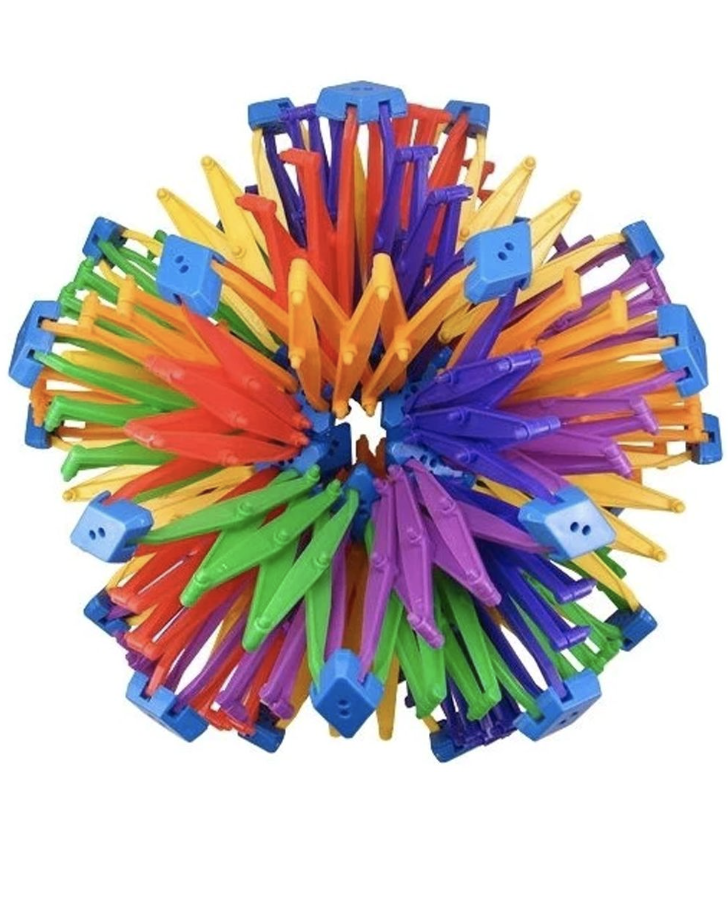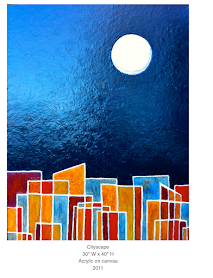This week's art adventure took me to explore the Bridges artwork from 2012, where I found these cool geometric shapes, especially spirals and repetitive patterns that reminded me of the Slinky toy and the Hoberman Sphere from my childhood. My first impression with the art pieces was "wow, these are really beautiful and colorful!"




Wanting to draw something familiar or imitate an artist, I came across Rodney Fulton's awesome work (Rodney Fulton, 2012), fascinated by his thoughts on overlapping shapes and balance within asymmetry.
Inspired by Fulton's art philosophy, I decided to draw a pineapple, sparked by my recent trip to Costco where I got two fresh ones. Rodney's deep understanding of geometric shapes, especially overlapping ones, guided how I arranged triangles, rectangles, and rhombi in my pineapple drawing.
Interestingly, my art journey aligns with the ideas shared by Capozucca and Fermani (2019). Though they focused on music, their idea of making math fun through art and music fits perfectly with my pineapple project, where hands-on creation becomes a bridge between different subjects.
Adding another layer to this exploration is our school's unique approach. We follow the International Baccalaureate Primary Years Programme (IBPYP), connecting art, music, and more. Currently exploring "How The World Works," our study of states of matter, like gas, solid, and liquid, sparks connections between different subjects. In our dynamic learning environment, students don't just stick to textbooks. We do hands-on experiments, measure things like scientists, and turn writing time into a chance to be authors, documenting experiences through procedural books. From science experiments to making pinch pots in art class, these experiences show how subjects seamlessly blend, creating a well-rounded understanding.
Rodney Fulton's quote, "Geometric shapes intrigue me, especially overlapping ones," rings true in my pineapple creation, where overlapping shapes convey both artistic expression and mathematical intricacies. Following Fulton's love for simplicity and interlocking shapes, my pineapple drawing became a canvas where each geometric element contributed to the overall look.
The interplay between art and math mirrors Capozucca and Fermani's idea of making math exciting through art and music (Capozucca, & Fermani, 2019). This philosophy comes to life in the hands-on workshop of my pineapple project, showing how artistic expression enhances understanding of math.
In essence, my pineapple artwork goes beyond being just a drawing; it becomes a testament to how knowledge across subjects is interconnected. It embodies the essence of a transdisciplinary approach, encouraging students to be versatile thinkers and enthusiastic learners, resonating with both Rodney Fulton's philosophy and the principles advocated by Capozucca and Fermani. In this holistic learning journey, the pineapple serves as a bridge between artistic expression, mathematical exploration, and the dynamic transdisciplinary approach embraced by our school.
Reflective Questions:
- How can I integrate the concept of overlapping shapes and the artistic-mathematical connection showcased in the pineapple drawing into engaging activities for my Grade 1 students to foster a love for both art and math?
- In what ways can I integrate the transdisciplinary approach in our school, as discussed in the blog, to create hands-on experiences that make math and art more enjoyable and interconnected for my young learners?
Reference







I loved your pineapple art, Sue! It's always a joy to see you activities, since you're also approaching it from an angle that young students might appreciate. It's a constant inspiration!
ReplyDeleteThe one place that I've really felt comfortable (or at least moderately successful!) incorporating art with math is in Grade 1 and 2 geometry. In the past, I've done activities primarily around mosaics and tiling, since it's engaging, hands on, and meets all of the math standards around patterning and ideas like surface area! For example, students would make a mosaic, then calculate the surface area of each colour by counting and extrapolating based on a single tile. This can be done with all square tiles, or with tiles of many shapes to make the calculations more interesting for older students! As I develop as an educator within the IB PYP program, the more I've had to challenge myself to find these integrations so that subjects are not siloed but transdisciplinary.
What I like about your approach is that it encourages students to see the world in a different way, rather than recreating an existing artistic medium. By using shapes to represent objects they find in their real lives, students are pushed to reconsider how they view the world and see the math around them rather than a medium that already lends itself to mathematical viewing. I'll definitely consider how to further integrate these ideas!
Hi Sue
ReplyDeleteI really enjoyed reading about your art adventure and the creative journey that led you to create a captivating pineapple drawing. Indeed, your connection between Rodney Fulton's geometric shapes, the overlapping elements, and the exploration of mathematical intricacies is inspiring. Therefore, your pineapple artwork powerfully illustrates the possibilities that arise when art, math, and a transdisciplinary approach converge.
I also appreciate the reflective questions you posed at the end, especially regarding integrating the concept of overlapping shapes into activities for Grade 1 students. This is an excellent opportunity to instill a love for art and math from a young age. Perhaps you could design hands-on activities that involve creating simple geometric shapes and encourage students to experiment with overlapping them to form new patterns.
Also, your exploration of a transdisciplinary approach is fantastic. To further integrate this into your school, consider organizing collaborative projects that involve multiple subjects. For example, a project that combines art, math, and science could have students create three-dimensional models of states of matter, using geometric shapes and artistic expression to represent each state.
Thank you for sharing your experience this week!